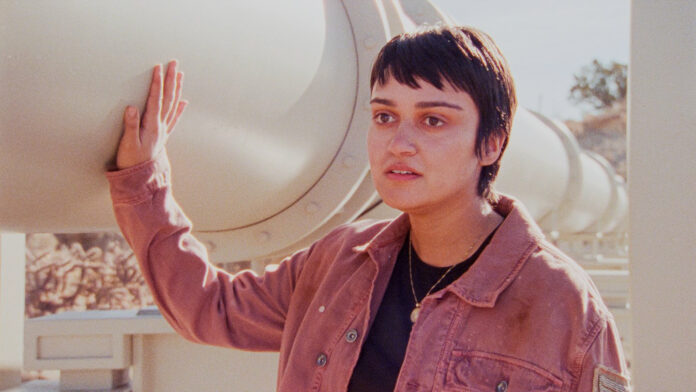How to Blow Up a Pipeline is an environmental thriller in which the title is literal. Young activists fight the power by conspiring to take out an oil pipeline. There’s the plot. Daniel Goldhaber’s second feature spins out like a heist film, the suspense baked into the premise. It is also a process film in which the actions of the conspirators are revealed step by step.
“I love a process movie,” Goldhaber says over Zoom. “I think it’s one of those things that just ends up being inherently cinematic. I think there are certain things that people just like to watch and people love to watch other people doing things. It’s the reason why Twitch is so popular. People even like to watch people play video games. It’s just a very natural human impulse.
“I think that it’s one of the things that the movie benefits from, we all kind of have a voyeuristic curiosity of what it actually looks like to blow up a pipeline. I think the movie takes advantage of that and the natural suspense that’s created by that circumstance to kind of spin out a piece of entertainment.”
How to Blow Up a Pipeline began with co-writer Jordan Sjol. He, Goldhaber, and their co-writer Ariela Barer (who also stars in the film) had been wanting to find something they could work on together. Sjol, a PhD candidate in literature at Duke University, had long talked about the idea of adapting a work of academic theory into film. But when he sent Goldhaber Andreas Malm’s How to Blow Up a Pipeline: Learning to Fight in a World on a Fire, a 2021 book that makes the case for sabotage in the battle against climate change, it was just for Goldhaber to read. Halfway through it, the director imagined a group of kids grappling with a bomb in the desert.
“That suggested just an exciting take on a movie,” Goldhaber says. “The idea of taking that title and those ideas was screaming to be adapted into a heist action film. That was a real lightning bold moment for us.”
The three writers threw themselves into research to determine where the movie might take place, who the conspirators might be, and what might motivate them to act. They also needed to figure out how to build a pipeline they could then explode. Goldhaber credits Barer with cracking open the puzzle.
“Ariela put the pieces of the ensemble together, specifying the eight characters that make up the film,” he says. “She wrote the opening 10 pages, which set the tone for the rhythm and pace of the movie and established who these people are.”
Goldhaber likens the film to Quentin Tarantino’s Reservoir Dogs, Stanley Kubrick’s The Killing, and Stephen Soderberg’s Ocean’s 11—heist films all. One big difference between those films and How to Blow Up a Pipeline is that greed is not a motivating factor for the eight people at the heart of Goldhaber’s film. Many in the octet are strangers to one another and varying factors push them to extreme action. And the tension in the film comes not just from what the group is trying to execute but to what happens when the action is over.
“I think everybody has collateral damage to some extent,” Goldhaber says.

If the title How to Blow Up a Pipelineis a tell, it is one with which Goldhaber doesn’t have an issue. One of his favorite movies is Robert Bresson’s 1956 thriller, A Man Escaped, about an imprisoned World War II French Resistance fighter struggling to flee his Nazi captors and execution.
“The movie tells you he escapes in the title, but I think there’s this weird thing that audiences have where they’re like, ‘Well, he’s not going to escape,’” Goldhaber says. “You don’t want to believe that the thing you’ve initially been told could possibly be true, because of the way our understanding of storytelling works.
“It’s a lesson I first learned when I was a kid watching Double Indemnity. The main character comes in and he’s been shot. Despite Billy Wilder having told us that this guy doesn’t get away with it, you spend the entire movie convinced he’s going to get away with it. I really love those little things that play with audience expectations like that.”
Goldhaber’s parents work in climate science, so he grew up with the reality of our warming planet. The tactics employed by his film’s characters are the type that Andreas Malm embraces in his book. But the director notes his movie is no polemic.
“We all have a working knowledge of climate change, but I think that you don’t need to know that much to feel the weather changing, to smell the death in the air,” Goldhaber says. “But I think our film is not necessarily a call to action. It’s a provocation to ask audiences to think about what tactics will be necessary and defensible to prevent a climate apocalypse and to reckon with the existential stakes for our planet and for human life on earth if we continue to burn fossil fuels.
“If you reckon with the consequences, then I think that engaging in acts of defiance and resistance are sensible. We just hope that the movie encourages people to consider that activity and to do what they think is right.”
How to Blow Up a Pipelineopens at Bay Area theaters on Friday, April 7.




